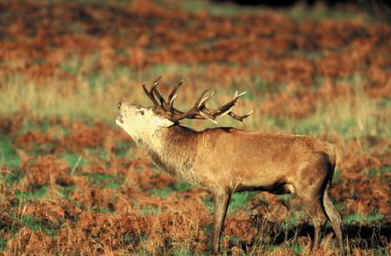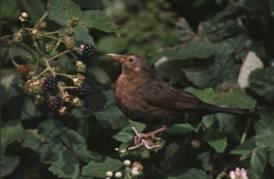Countryside Rangers Diary
October- The time is coming to get out your winter woollies and pull on your gloves but don't let this deter you from coming to the park for a walk.
The frosts will soon transform the countryside, sending insect numbers plummeting and leaves spinning to the ground, where the wind will whisk them into heaps. This is a great time for wildlife watching; when the leaves have fallen it's hard for animals to hide from view.
This is the best time to see the deer, they are rutting during October. It is interesting to watch the rutting behaviour of the different deer species. The Fallow bucks (males) make a rutting stand. Each individual chooses a spot where he will stand and bellow, he scrapes the ground clear of vegetation and urinates repeatedly over it so it takes on his distinctive smell. This advertises his presence to the does (females) who go from one to the next eventually selecting the buck with which they mate.

The red deer follow a different routine. The stag (male) collects together a harem of hinds (females) around him. He spends all his time keeping these females together and will mate with them when they come into season. Younger stags often stay at the edge of the main group hoping to steal a hind from the main stag! If another of similar size challenges the stag they perform an elaborate display of parallel walking. Each stag is sizing up the other; if either feels he is the weaker he will turn and make his escape. If however they are equally matched they will clash antlers and a battle of strength ensues. This will continue until both are exhausted or one shows he is stronger than the other. These battles are extremely exciting to watch.
 Many species of birds form into large flocks at this time of year, this is a natural response to the superabundance of food that is available to them. In the park the beech trees can produce an amazing crop of beech mast. A single tree can provide a tonne of succulent nuts. This is enough to keep a flock of 500 chaffinches alive for 6 months (although, of course, many other animals take advantage of this food source, too).
Many species of birds form into large flocks at this time of year, this is a natural response to the superabundance of food that is available to them. In the park the beech trees can produce an amazing crop of beech mast. A single tree can provide a tonne of succulent nuts. This is enough to keep a flock of 500 chaffinches alive for 6 months (although, of course, many other animals take advantage of this food source, too).
Other plants produce berries and fruit; all are a direct invitation for the birds. If this month is mild many of these fruits are ignored in favour of insects that the birds find in the soil. When the temperature drops and the ground freeze the fruit and berries provide a vital food reserve for all the birds.
A great month to be enjoying the park!